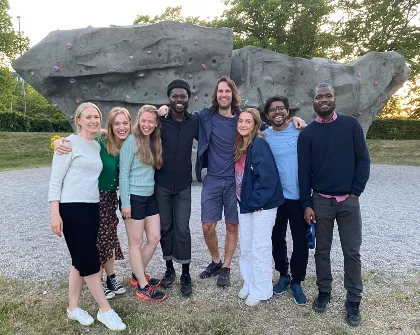Through their efforts, we are gaining a better understanding of cancer formation and developing diagnostic tools for early detection, while also exploring ways to prevent tumor growth and much more. In this article, we take a closer look at a few of these initiatives:
Diagnosis in a breath: Lung cancer diagnosis through exhaled breath particles
Lung cancer is a severe form of cancer and detecting it at an early stage is critical for effective treatment. Dr. Sandra Lindstedt, a senior consultant in thoracic surgery at Skåne University Hospital and an adjunct professor at Lund University, is leading a team to develop a non-invasive diagnostic tool for lung cancer. The project funded by Cancerfonden, will focus on using exhaled breath particles as a non-invasive method for diagnosing and monitoring non-small-cell lung cancer.
“The reduced invasiveness of exhaled breath particles as a diagnostic tool could encourage more frequent screenings. We hope that this new method will foster a culture of proactive health management and shift the paradigm towards preventive care, in addition to paving the way for more effective treatments,” says Sandra Linstedt, research group leader at Lund Stem Cell Center.
The team believes that this approach holds the promise of enabling timely interventions, significantly enhancing treatment success rates, and ultimately improving patient survival rates. It also offers a significant advantage in monitoring recurrence. “By continuously analyzing breath particles, we anticipate the ability to detect any signs of lung cancer recurrence at an early phase, facilitating prompt medical attention and tailored treatment strategies,” explains Sandra Linstedt.
Studying salamanders to decode the link between regeneration and cancer formation
Salamanders have a unique ability to regenerate their limbs and have shown resistance to cancer in previous studies, making them a fascinating animal species for researchers in the field of regenerative medicine. Nicholas Leigh, associate senior lecturer at Lund University, and research group leader at Lund Stem Cell Center, and his team are studying salamanders to understand the connection between regeneration and cancer formation.
Nicholas Leigh explains, "If you have a Venn diagram of what is happening in regeneration and what is happening in cancer, there is significant overlap. With recent advancements in CRISPR and sequencing technologies, we can now start to test the limits of why these animals do not develop cancer and dig into the mechanisms that exist to prevent its development."
Salamanders have a set of genes called tumor suppressors, which, as the name suggests, are capable of suppressing tumors. These genes also appear to be involved in their limb generation. The team has been awarded a grant by Cancerfonden to further their research into the tumor suppressor genes found in salamanders. By studying these genes and comparing them to human genes, they hope to find new ways to suppress cancer growth and better understand the mechanisms of regeneration.
Influencing cell transformation to block the spread of breast cancer
With an estimated 2.5 million new cases of breast cancer diagnosed globally each year, the need for innovative treatment options is pressing. Sandeep Gopal, a research group leader at Lund Stem Cell Center and the Lund University Cancer Center, and his team are exploring a potential avenue for breast cancer treatment by studying the process of Epithelial to Mesenchymal Transition (EMT). EMT is a process where cells undergo a transformation, often initiating the spread of cancer. The team is focusing its efforts on glycosylated calcium regulators to impact EMT.
“The alterations in glycosylation are a reliable hallmark of cancer. We discovered that glycan chain bearing proteins control how calcium is regulated within cells, which can potentially affect cancer progression. Although we know these proteins play a big part in cancer progression, we need to study them further to understand and target them for treatment,” highlights Sandeep Gopal.
With funding from the Swedish Research Council and Cancerfonden, the team is now investigating how the glycosylated proteins impact calcium regulation during breast cancer progression. These chains, found on the surface of cells, could potentially be used as drug targets for new breast cancer treatments. With further study and research, Sandeep Gopal and his team hope to identify a new and effective treatment option for breast cancer.
Investigating the prenatal events that lead to pediatric leukemia
Acute Lymphoblastic Leukemia (ALL) is the most common form of cancer in children. Dr. Charlotta Böiers, associate professor at Lund University, and research group leader at Lund Stem Cell Center, has been awarded grants from the Swedish Research Council, Cancerfonden, and Barncancerfonden to support her research into ALL. Her research aims to understand the aggressive mutations in the MLL gene, associated with a worse prognosis, and to identify what causes a cell in utero to become cancerous.
Charlotta and her team will focus on what happens before the start of the disease and how it affects different cells at the beginning of the disease process. "If we can understand these early changes and the course of the disease in its entirety, we hope to find new treatment strategies, that more specifically attack the diseased cells," says Charlotta Böiers.
This is particularly important as up to 7 out of 10 children suffer from late complications caused by cancer treatment, and a third of those are serious, even life-threatening, as reported by Barncancerfonden. "The goal is to one day cure all children who get ALL," notes Charlotta, emphasizing the importance of the grants received from the funding agencies to carry out this research.
"We are excited and grateful for the funding we’ve received. With this support, we can continue to push the boundaries of knowledge and work towards new treatments for cancer," adds Charlotta Böiers.






